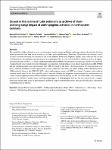Item Infomation
Full metadata record
| DC Field | Value | Language |
|---|---|---|
| dc.contributor.author | Simon, Marcel Pierre | - |
| dc.contributor.author | Schatz, Marlene | - |
| dc.contributor.author | Böhm, Leonard | - |
| dc.date.accessioned | 2023-08-07T09:15:57Z | - |
| dc.date.available | 2023-08-07T09:15:57Z | - |
| dc.date.issued | 2023 | - |
| dc.identifier.uri | https://link.springer.com/article/10.1007/s11356-023-28210-8 | - |
| dc.identifier.uri | https://dlib.phenikaa-uni.edu.vn/handle/PNK/8738 | - |
| dc.description | CC-BY | vi |
| dc.description.abstract | The suitability of lake sediment cores to reconstruct past inputs, regional pollution, and usage patterns of pesticides has been shown previously. Until now, no such data exist for lakes in eastern Germany. Therefore, 10 sediment cores (length 1 m) of 10 lakes in eastern Germany, the territory of the former German Democratic Republic (GDR), were collected and cut into 5–10-mm layers. In each layer, concentrations of trace elements (TEs) As, Cd, Cr, Cu, Ni, Pb, S, and Zn, as well as of organochlorine pesticides (OCPs), i.e., dichlorodiphenyltrichloroethane (DDT) and hexachlorocyclohexane (HCH), were analyzed. A miniaturized solid–liquid extraction technique in conjunction with headspace solid-phase microextraction (HS-SPME) and gas chromatography–mass spectrometry (GC–MS) was used for the latter. | vi |
| dc.language.iso | en | vi |
| dc.publisher | Springer | vi |
| dc.subject | OCPs | vi |
| dc.subject | GC–MS | vi |
| dc.title | Dissent in the sediment? Lake sediments as archives of short- and long-range impact of anthropogenic activities in northeastern Germany | vi |
| dc.type | Book | vi |
| Appears in Collections | ||
| OER - Khoa học môi trường | ||
Files in This Item:

